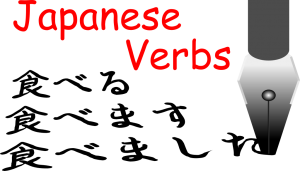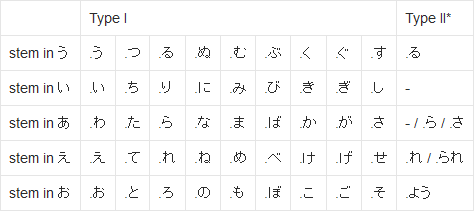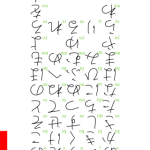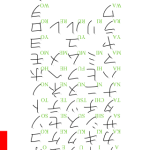Hello Everyone,
Here is a new series of articles where we are going to study verbs in Japanese. In this introductory lesson you will discover verb stems as well as the verbs plain and -ます forms. Let’s go!
Basics of Japanese verb conjugation
Stem and forms
In Japanese, a verb consists in:
- a stem, which is the base part common to the different conjugated forms of the verb,
- and a suffix which depends on the verbal form (past, present/future, volitional…) to which the verb is set.
Exercise:
Let’s have a look at the following verb in different conjugated forms:
たべる
たべます
たべない
たべられる
Based on the definitions above, try to identify the stem of the verb, and the form suffixes.
Answer:
The stem of the verb is たべ, and we have 4 different form suffixes: .る, .ます, .ない and .られる.
Did you find the correct answer? If not, don’t worry. Look carefully at the definitions and the expected answer to see the logic behind it. It may not be straightforward but you will make it with a little practice.
Verb Groups
Japanese verbs are classified into 3 groups. Knowing the group of a verb is important as it will condition the way the stem gets declined during conjugation.
Before we see the group definitions though, note the following points:
- In the following definitions, a dot “.” is used to indicate the limit between the stem and the verbal form. For instance for the following conjugated verb: たべる, we will use たべ.る to make the distinction between the stem たべ and the verbal form suffix る.
- The notation “・あ” indicates a kana ending in the sound [a], “・い” the sound [i]… For instance ・い can either represent the kana い, or き, or し…
- Finally, the definition of the groups themselves is based on the ・う declination of the stem, which comes to be the dictionary form of the verb.
Here are the definitions of the 3 groups:
一段動詞 (いちだんどうし) or Type II
The dictionary form of these verbs ends in either ・い.る or ・え.る, but pay attention: not all verbs ending with ・い.る or ・え.る are Type II verbs. The stem declination is the same for all the verbs in this group.
変格活用 (へんかくかつよう) or Type III
This is the group of the irregular verbs; but don’t worry there is only two of them: 来る (く.る) / to come / and す.る / to do /. The declination of the stem of these verbs is specific and we will see it case by case.
五段動詞 (ごだんどうし) or Type I
This group encompasses all the other verbs: the ones that end in either ・い.る or ・え.る but are not type II verbs, and all other ・う dictionary forms (.す, .ぐ, ・あ.る…). We will see in the next chapter that the stem of the verbs in this category can have 5 different declinations, each corresponding to one of the 5 Japanese vowels.
One special note also for the です, which is a contracted form which origin is unsure but basically has the meaning of / to be / and is assimilated to the English copula “is”. This copula has a specific conjugation even though it isn’t assimilated as an irregular verb.
Exercise:
Let’s give this some practice: Using the rules above, try to find the group of the following verbs at their dictionary forms.
- たべ.る / to eat /
- はな.す / to speak, to talk /
- か.う / to buy /
- す.る / to do /
- かえ.る / to come back /
- み.る / to look /
Answers:
- たべ.る / to eat /
- Type II, ends in ・え.る
- はな.す / to speak, to talk /
- Type I, ends in す
- か.う / to buy /
- Type I, ends in う
- す.る / to do /
- Type III, irregular
- かえ.る / to come back /
- Type I, this one is an exception to the Type II verbs definition
- み.る / to look /
- Type II, ends in ・い.る
Stem declinations
The table below shows how to build the different stem declinations for Type I and Type II verbs.
The declination consists in changing the syllable following the stem in the verb’s dictionary form. As we said earlier, the dictionary form is the ・う declination of the verb, or what we will call stem in う from now on.
*For Type II verbs’ stem in あ and え, the exact declination depends on the verbal form.
Let’s see some examples:
- たべ.る / to eat / – Type II
- stem in う (dictionary form)
- たべ.る
- stem in い:
- たべ
- stem in あ
- たべ
- たべ.ら
- たべ.さ
- stem in え
- たべ.れ
- たべ.られ
- stem in お
- たべ.よう
- stem in う (dictionary form)
- か.う / to buy / – Type I
- stem in う (dictionary form)
- か.う
- stem in い:
- か.い
- stem in あ
- か.わ
- stem in え
- か.え
- stem in お
- か.お
- stem in う (dictionary form)
- の.む / to drink / – Type I
- stem in う (dictionary form)
- の.む
- stem in い:
- の.み
- stem in あ
- の.ま
- stem in え
- の.め
- stem in お
- の.も
- stem in う (dictionary form)
Exercise:
Try it yourself with はな.す and かえ.る which we saw earlier…
Answers:
- はな.す / to speak, to talk / – Type I
- stem in う (dictionary form)
- はな.す
- stem in い:
- はな.し
- stem in あ
- はな.さ
- stem in え
- はな.せ
- stem in お
- はな.そ
- stem in う (dictionary form)
- かえ.る / to come back / – Type I
- stem in う (dictionary form)
- かえ.る
- stem in い:
- かえ.り
- stem in あ
- かえ.ら
- stem in え
- かえ.れ
- stem in お
- かえ.ろ
- stem in う (dictionary form)
Quite easy, isn’t it?
Note that you don’t have to know perfectly this table for the moment, I will make references to it all along our lessons around verbs and you will come to learn it little by little.
The Plain form
The plain form of a verb is in fact what we saw earlier as the dictionary form. Indeed, the notion of infinitive does not exist in the Japanese language, all the conjugation rules are based on an already conjugated form.
Therefore, the plain form is used:
- as the dictionary form of a verb
- in casual present/future tense
Casual speach is to be used with close acquaintances or people you show despise to.
Construction:
Stem in う of the verb.
Copula: だ
Examples:
- Type I:
- 話す (はなす) / to talk, to speak / or / I, you, he, she, we, they talk(s)/speak(s) /
- Type II:
- 食べる (たべる) / to eat / or / I, you, he, she, we, they eat(s) /
- T-III:
- 来る (くる) / to come / or / I, you, he, she, we, they come(s) /
- する / to do / or / I, you, he, she, we, they do(es) /
Note 1: Minimal sentence
In the Japanese language, a verb can be used alone to form a sentence if the context alows it, and pronouns are scarcely used.
Therefore if someones calls you on the phone while you are eating and asks you what you are doing, you can simply answer:
たべる。 / (I) eat. /
But remember this is plain/casual language and therefore that it may sound gross to many Japanese people. You should generally prefer the use of the -ます form that we are going to see now.
Note 2: Future
As you may have spotted, the plain form is used for both present and future tenses. This is because in Japanese the notion of future tense does not exist. To express future, Japanese use temporal expressions (tomorrow, in 10 days…) plus the present tense. This is somehow like saying: “Tomorrow I go to swimming pool.” instead of the proper English version: “Tomorrow I will go to the swimming pool.”.
The -ます form
The -ます form is used for:
- present polite tense
- future polite tense
This form is the one to be favored when you don’t really know if you should be casual or polite with someone.
Construction:
Stem in い + ます.
Copula: です
Examples:
- Type I: 話す (はなす)
- stem in い: 話し (はなし)
- + ます ⇒ 話なします (はなします) / I, you, he, she, we, they talk(s)/speak(s) /
- Type II:食べる (たべる)
- stem in い: 食べ (たべ)
- + ます ⇒ 食べます (たべます) / I, you, he, she, we, they eat(s) /
- Type III:
- 来る (くる) ⇒ 来ます (きます) / I, you, he, she, we, they come(s) /
- する ⇒ します / I, you, he, she, we, they do(es) /
Exercises:
Conjugate the following verbs at the -ます form (remember that the given stem declination is the stem in う).
読む(よむ) / to read /
Example use: 本を読みます。(ほん を よみます。) / I* read a book. /
(*) I use “I” here, but since the pronoun is contextual and not expressed I could have used “you”, “he”, “she”, “we”, or “they”.
見る(みる) / to see, to look /
Example use: テレビを見ます。(テレビ を みます。) / You watch television. /
泳ぐ(およぐ) / to swim /
Example use: 海で泳ぎます。(うみ で およぎます。) / They swim in the ocean. /
行く(いく) / to go /
Example use: 明日、学校に行きます。(あした、がっこう に いきます。) / Tomorrow, I will go to school. /
Here it is for this lesson. Do not hesitate to comment and ask questions if you have any, either on the blog or on social media:
- Facebook: https://www.facebook.com/WonderLang.xyz/
- Twitter: https://twitter.com/wonderlang_xyz
- Google+: https://plus.google.com/106961151498223949055
- Reddit: https://reddit.com/r/wonderlang
- Instagram: https://instagram.com/wonderlang_xyz
- YouTube: WonderLang YouTube channel
Stéphane





